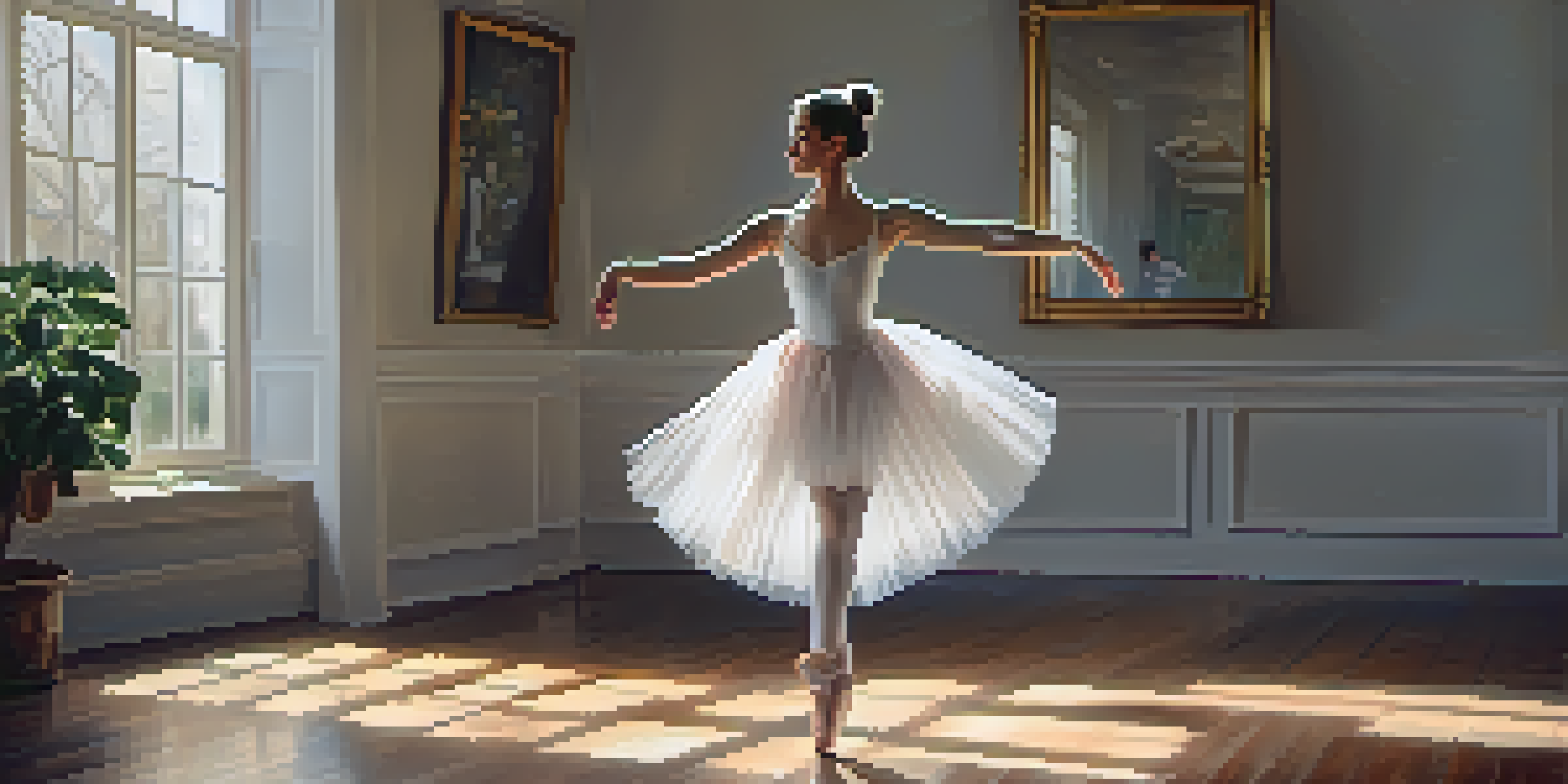The Connection Between Dance and Emotional Well-being

Dance as a Form of Emotional Expression
Dance serves as a powerful outlet for expressing emotions that may be difficult to communicate verbally. The rhythmic movements and creative flow allow individuals to convey feelings of joy, sadness, or even anger in a physical form. For many, this act of movement becomes a cathartic release, letting them process complex emotions in a safe space.
Dance is the hidden language of the soul.
Consider a dancer gracefully moving across the stage; each step and twirl reflects a story that words alone might fail to tell. This connection between body and emotion can also foster a deeper understanding of one's feelings. By embodying different emotions through dance, individuals can gain insight into their emotional landscape.
Moreover, the act of dance can be a personal journey that varies from one person to another. Whether it's the elegance of ballet or the energetic beats of hip-hop, each style offers unique ways to express and explore one’s emotions, making dance a versatile tool for emotional exploration.
The Science Behind Dance and Mental Health
Research has consistently shown that dance can have a positive impact on mental health. Studies indicate that engaging in dance activates the brain's reward system, releasing endorphins that contribute to feelings of happiness and reduced stress. This biochemical reaction is similar to what one feels after a good workout, making dance an enjoyable way to boost mood.

Additionally, dance also encourages social interaction, which is crucial for maintaining emotional well-being. Group classes or dance partnerships create a sense of community and belonging, helping to reduce feelings of isolation. This social aspect can be particularly beneficial for individuals grappling with anxiety or depression.
Dance as Emotional Expression
Dance allows individuals to express complex emotions physically, fostering a deeper understanding of their feelings.
Furthermore, the focus required during dance practices can serve as a mindfulness exercise, distracting the mind from negative thoughts. This combination of physical activity, social engagement, and mindfulness creates a multifaceted approach to improving mental health, making dance an effective therapeutic tool.
Dance as a Tool for Stress Relief
In today's fast-paced world, stress can feel like an inevitable part of life. Fortunately, dance offers a joyful escape that can alleviate stress and tension. Whether it’s moving to your favorite song in the living room or participating in a structured dance class, the act of dancing can help release pent-up energy and emotions.
Dancing is like dreaming with your feet.
When you dance, your body enters a state of flow, which can feel incredibly liberating. This state allows you to forget about everyday worries and immerse yourself in the present moment. The combination of music, rhythm, and movement can be incredibly therapeutic, helping to clear your mind and uplift your spirits.
Moreover, the physical benefits of dance, such as improved flexibility and strength, can also contribute to overall well-being. As you become more in tune with your body, you may experience increased confidence, leading to a more positive outlook on life—a helpful antidote to stress.
Building Self-esteem Through Dance
Engaging in dance can significantly boost self-esteem and body image. As individuals learn new moves and techniques, they often experience a sense of accomplishment and pride in their abilities. This newfound confidence can transcend the dance floor, positively impacting other areas of life.
Think about the transformative power of performing in front of an audience. The thrill of showcasing hard work and passion can reinforce a dancer's sense of self-worth. Overcoming stage fright and receiving applause can create lasting memories that build resilience and confidence.
Boosting Mental Health Through Dance
Engaging in dance activates the brain's reward system, enhancing mood and promoting social interaction.
Moreover, dance encourages individuals to embrace their bodies, regardless of size or shape. This acceptance fosters a healthier relationship with oneself and can combat negative self-talk, making dance a valuable practice for enhancing overall self-esteem.
Dance and Its Role in Community Building
Dance has a remarkable ability to bring people together, creating a sense of community and belonging. Whether it’s a local dance class, a cultural festival, or a social dance event, these gatherings foster connections among individuals. This shared experience can create lasting friendships and support systems.
In many cultures, dance is a fundamental aspect of celebrations and rituals, emphasizing its role in community identity. Participating in these practices can strengthen ties and offer a sense of purpose and belonging, essential for emotional well-being.
Additionally, communities that engage in dance activities often promote inclusivity and diversity. By welcoming individuals from various backgrounds, dance nurtures understanding and acceptance, creating a richer, more supportive environment for everyone.
Dance Therapy: A Professional Approach to Healing
Dance therapy is an established therapeutic practice that uses movement to promote emotional, cognitive, and physical integration. Certified dance therapists guide individuals in exploring their emotions through movement, helping them to process trauma and stress in a supportive environment. This professional approach can be particularly beneficial for those who find traditional talk therapy challenging.
During dance therapy sessions, clients are encouraged to express themselves freely, allowing for a unique exploration of feelings and experiences. The therapist observes and facilitates, helping clients make connections between their movements and emotions. This can lead to profound insights and healing.
Dance Builds Community Connections
Participating in dance fosters a sense of belonging and inclusivity, strengthening community ties and support systems.
Moreover, dance therapy is inclusive, suitable for all ages and abilities. Whether someone has dance experience or not, the focus is on expression rather than perfection, making it an accessible form of therapy for anyone seeking emotional well-being.
Integrating Dance into Daily Life
Incorporating dance into your daily routine doesn't require a formal class or extensive training. Simple activities like dancing while you cook, taking a dance break during work, or joining a local dance group can seamlessly integrate movement into your day. This can create joyful moments that enhance emotional well-being without feeling like a chore.
Using platforms like YouTube or dance apps can also make it easy to learn new styles from the comfort of your home. These resources allow you to explore various dance forms, from Zumba to contemporary dance, making it a fun way to stay active and engaged.

Ultimately, the key is to find joy in movement. By prioritizing dance as a part of your life, you can tap into its numerous emotional benefits while enjoying a creative and fulfilling experience.